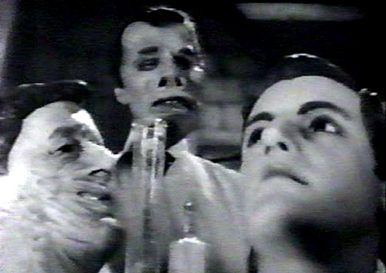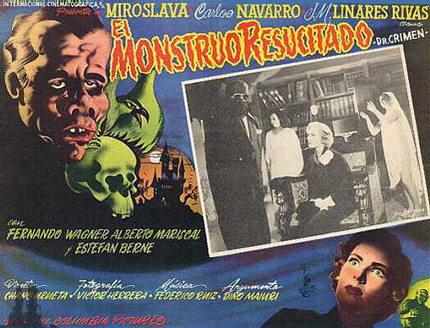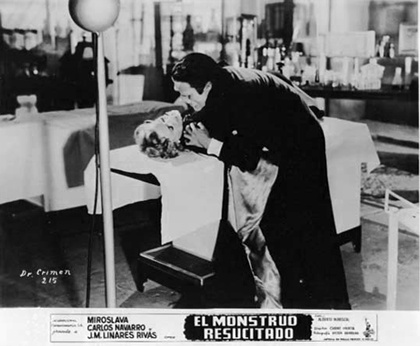
 |
|
|
|
Ever since the boutique DVD label CasaNegra went quiet a few years ago we haven't seen much new in the way of Mexican horror or science fiction offerings, which makes One 7 Movies' DVD release of the unusual (to say the least) 1953 Azteca production Monster all the more interesting. Better known as El monstruo resucitado (The Revived Monster), this single title is credited by horror film historians with re-starting the craze in Mexican horror and introducing the modern subgenre known as medical horror. (In this reckoning the isolated 1932 Paramount classic Island of Lost Souls doesn't count.) El monstruo resucitado is usually described as an odd variation on the Frankenstein theme, but proves to be a lot more than that. Horror fans will instantly recognize that the Mexicans are carrying on the tradition of classic '30s Universal horror. Added to the mix is a bizarre dimension of exotic, delirious romanticism, in the soapy tradition of Mexican potboilers. 
The director is Chano Urueta, who made several prime Mexi-horrors; you've probably seen him in Sam Peckinpah's The Wild Bunch, playing the cacique of Agua Verde, the old man who says, "In Mexico, señor, these are the years of sadness." 1 Urueta co-wrote the screenplay with Dino Maiuri (Arduino Maiuri), a transplanted Italian who must have been in the first wave of jet-setters. Maiuri is also the key writer of Mario Bava's Diabolik, made fifteen years later in Rome. These two cook up a story that makes almost no sense at all, yet yields a constant flow of weird genre flourishes. Bored investigative reporter Nora (Miroslava) lacks a story, so her editor Gherásimos (Fernando Wagner) has her answer a mysterious want ad for a 'special companion for a very special man.' At the appointed rendezvous Nora finds a masked and caped mystery man who calls himself Hermann Ling (José María Linares-Rivas). Nora accompanies Ling to his mansion on a cliff over the sea, next to a graveyard. They are waited on by the deformed servant Mischa (Alberto Mariscal) in a room appointed with wax statues of women in strange poses. Ling is both an artist and a scientist surgeon; he shows Nora before & after wax busts of a man whose burned face he has rebuilt (above). Ling balks at revealing his own face, instead regaling Nora with a speech about how he was born deformed. He hates mankind, but is hoping beyond hope to find a woman that understands him. Even after the big reveal of Hermann's face, Nora says that she wants to help him. She gives him a kiss, whereupon the grotesque man flies into ecstasy, uncovering the mirrors on his walls. With Nora at his side, Ling vows to dedicate his life to helping people. Unfortunately, Ling later overhears Nora reporting to Gherásimos that she's successfully humored Ling and can now get what she needs to write the most important news article of her career. Hermann Ling skulks back to his laboratory and tells Mischa that his vengeance will be diabolical: he'll revive the corpse of a newly-buried man (Carlos Navarro) and telepathically control him, to woo Nora into a false sense of security before killing her! 
Mexican horror films are nothing if not ambitious -- and enthusiastic. El monstruo resucitado is just plain nuts from the first scene foward, crazy in a way that will enthuse any fan of horror. Nora blithely goes off with a guy who looks like The Invisible Man (large dark glasses) crossed with The Lodger (cloth mask over his face, broad-brimmed hat). His theatrical excesses are a match for The Phantom of the Opera and his relationship to Nora could be interpreted as Beauty and the Beast with a cynical female at the center. And that's all before we get to the Frankenstein material! Thought dead for ten years, Hermann Ling is the most talkative man of mystery in film history: he rambles on as if stricken by terminal loneliness, telling Nora to pay no attention to the bizarre, disturbing things she sees in his house (skulls on the piano, etc.). She isn't bothered by the creepy, pale statues of half-dressed women here and there around the main room. Ling contradicts himself several times in his speeches. He raves about taking revenge on humanity, especially women, and then rushes to add that, should Nora appreciate his soulful state, he'd be devoted to her forever. Nora will later claim that she's merely taking advantage of Hermann, but her heavy-breathing response to the mad scientist's declarations of joy and love seems pretty sincere. 2 
Things just get crazier. The ugly Ling transfers the life force from an ape-man he keeps in the basement to the handsome corpse on his operating table. We learn nothing about the origin or identity of the hairy man (Stefan Berne) except that his name is Cronink. Dr. Ling calls the newly revived corpse (so, should we call him a zombie?) Ariel, who then goes forth doing Ling's murderous bidding using his old name, Serguei Rostov. Nora is confirmed as a real pushover, as Serguei needs only to warm her up with a few professional compliments, endearments and a gift of some flowers, and she's ready to follow him everywhere as well. Of course, Ariel/Serguei is delivering Nora back into Hermann Ling's EVIL clutches. The mad doctor has gone to a hell of a lot of trouble just to kidnap one woman... does Ling create a new zombie every time he needs to buy groceries, or to get the car lubed? Hermann Ling's face is not a masterpiece of the art of movie makeup. It looks almost like a Mardi Gras mask, definitely goofy but not quite as absurd as the one used for the "Brainiac" in Abel Salazar's The Baron of Terror. Ling does accurately describe it as stiff and immobile, and it certainly fits in perfectly with Monstruo's hyper-goofy tone. To me, Hermann Ling looks like an elephant man version of Ed Sullivan. Chano Urueta's camera direction keeps pace with the theatrical delirium of the performances by evoking the expressionist angles and lighting of Universal films. The art direction and designs are remarkable. A strange street (the story might be set in Europe, somewhere), a wharf and the cemetery are all drowned in an invitingly creepy fog. Ling's house interior is a neat multi-level set with excellent lighting. Ling's basement laboratory would seem to be patterned after Anton Grot's mad lab for Lionel Atwill in Mystery of the Wax Museum. But Ling is supposed to have sculpted the female figures in his living room, not created them by dipping women in wax. The statues are so good that they sometimes look like actresses standing very still. Mood and atmosphere are nicely modulated to support this appealingly absurd fantasy. 
One strange case of warped continuity crops up. When Ling first takes Nora from a wharf to his oceanside hideaway-castle, the trip requires a drive in his car. They enter the castle through a spooky graveyard. A subsequent foot chase begins in the graveyard, but Nora only has to run a couple of blocks on foot before she's at the wharf again. Did David Lynch's parents show this to him in his crib? Of course, why worry about geographical continuity when Dr. Ling has been missing for ten years, yet nobody has thought to search that fantastic castle perched on a sea cliff, right outside of town. Beautiful star Miroslava (Miroslava Sternova) is something of a grim legend in Mexico, where a movie bio about her was filmed in 1992. As Mexican immigration restrictions weren't as strict as ours, the country saw an influx in refugees from Nazidom in the late 1930s. Miroslava's family fled Czechoslovakia, and she hit her stride as a movie star in the late 1940s. But immediately after she completed a starring role in Luis Buñuel's Ensayo de un crimen (The Criminal Life of Archibaldo de la Cruz) Miroslava committed suicide over the lost love of a famous bullfighter. Even Buñuel was shaken. A look at the filmographies of the people responsible for this show reveals not a pack of industry fringe dwellers, but folk right at the center of popular filmmaking. With a few exceptions, U.S. horror pix in the early 1950s had practically disappeared; El monstruo resucitado is a homegrown horror show going in its own direction. One 7 Movies / CAV's DVD of Monster (El monstruo resucitado) is a welcome release of a rather rare show, but the presentation is nowhere near as polished as the group of Mexican horror classics brought out by CasaNegra in 2006. The title "Monster" appears to be made up for the DVD release, with no reason given. The film source looks to be a 16mm print of the Italian version, titled Il mostruoso dottor Crimen. But the audio track is in Spanish, and the English subtitles are removable. I'm no expert, but the English subs are written with an odd syntax, as if they had been translated from Italian subtitles with a computer program. 3 The main titles show some splices but most of the rest of the film seems reasonably intact. It still looks like a slightly dupe-y 16mm print, however, so contrast and sharpness are not exceptionally good. We can also tell that the formatting of the original film was most likely meant to be widescreen: the bottom of the frame has lots of empty space. 
The 80-minute running time conflicts with the IMDB's listing 0f 85, which looks right to me. The show does not seem to be a PAL conversion, and there is evidence of scenes or pieces of scenes having been lifted. A telltale splice remains during a murder in the street, just as the remote-controlled Ariel/Serguei approaches a young woman with a jagged piece of glass in his hand. A Mexican lobby card also shows an angle of the mad doctor actually performing mad surgery, with Mischa looking on (with that Ygor look in his eyes). No corresponding scene is in the picture. Yet another lobby card photo (above) shows Nora on the operating table -- which would seem to be a staged shot, as it doesn't fit in the existing movie's continuity. It's a shame that the restoration of prime Mexican cinema hasn't really happened as of yet. We have no way of knowing if good source materials exist for shows like El monstruo resucitado. Are these just the usual Italian censorship cuts, or is what's missing more gory or sexy than we'd expect to see? Just the same, El monstruo resucitado is such a rarity that One 7's enjoyable disc will be a worthy acquisition for hardcore horror fans (we know who you are). Ever seen Mexican vampire movies in their original versions? Or the elusive Orlak, el infierno de Frankenstein? Or the ridiculously cheesy comedies Las Astronautas or La nave de monstruos? I wish they were all available in quality releases.
On a scale of Excellent, Good, Fair, and Poor,
Monster (El monstruo resucitado) rates:
Footnotes:
1. Another actor in El monstruo resucitado, Fernando Wagner, was also a director; he played a role in The Wild Bunch as well. The Mexican film industry was tightly controlled by a close-knit group of insiders. Half the speaking roles in Peckinpah's movie are filled by Mexican movie directors. Some may have been hired as "advisors" to appease the powers that be in Mexico City.
2. I have to think that Pedro Almodóvar was thinking of this movie, or something just like it, when he conceived his masked muscleman/superhero fiend character for the movie-within-a-movie spoof in his ¡Átame! (Tie Me Up! Tie Me Down!). Ling's pompous, deranged speeches have a similar effect!
3. The audio track makes at least two mentions of Hermann Ling renaming himself "Dr. Crimen", as in the Italian title. But I listened to the audio track and did not hear that name anywhere near the corresponding subtitle. But I cannot conclude that the "Dr. Crimen" idea was added for the Italian dub only, because Mexican posters for the movie carry a secondary title, "Dr. Crimen", and so do some stills. So someone will have to explain it all to me. In fact, I'd pay money to attend a lecture by Guillermo Del Toro, if he were to address 1,001 confusing details in Mexican horror cinema. Do international cable channels exist that show vintage Mexican films? I understand enough Español to
Reviews on the Savant main site have additional credits information and are often updated and annotated with footnotes, reader input and graphics.
Review Staff | About DVD Talk | Newsletter Subscribe | Join DVD Talk Forum |
| ||||||||||||||||||